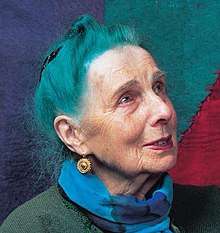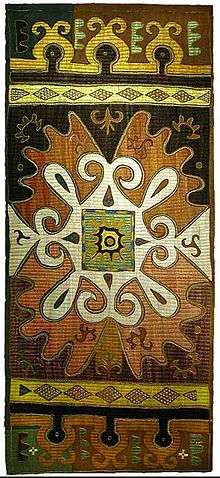Constance Howard (artist)
Constance Mildred Howard, later Constance Parker, (8 December 1910-2 July 2000) was an English textile artist and embroiderer who had a profound impact on the development and teaching of those subjects in Britain.[1] The Constance Howard Gallery, part of Goldsmiths, University of London, is named in her honour.[2]
Constance Howard | |
|---|---|
 Constance Howard | |
| Born | 8 December 1910 Abington, Northamptonshire, England |
| Died | 2 July 2000 (aged 89) Hindhead, Surrey |
| Nationality | English |
| Education |
|
| Known for | Textile arts and embroidery |
| Spouse(s) | Harold Wilson Parker, m.1945-his death. |
Biography
Howard was born in Abington in Northampton to Mildred Annie Abbott and Arthur Howard, a school teacher.[1] From the age of ten she began taking weekly classes at the Northampton School of Art and subsequently won a scholarship that allowed her to attend full-time when she turned 14.[1] From 1931 Howard was a student at the Royal College of Art in London where she was taught by both Eric Ravilious and Edward Bawden.[1] After graduating in 1935, Howard taught at the Cardiff School of Art where she established a course in dress design.[1] During World War II she taught at the Kingston School of Art where she and her students embroidered maps for the RAF.[1] In December 1945 Howard married the sculptor Harold Wilson Parker and gave up teaching but began exhibiting with the Arts and Crafts Exhibition Society.[1]
Howard returned to teaching in 1947 on a part-time basis with embroidery classes at Goldsmiths in east London.[3] In 1950 Howard designed a large textile hanging for the country pavilion of the Festival of Britain exhibition in London.[4] The Country Wife was completed by Howard and her students, who included Mary Quant, and depicted the activities of the National Federation of Women's Institutes.[5] In 1953 Goldsmith's established a separate department of embroidery and in 1958 Howard became its head of department.[1] In 1964 embroidery and textile design became a main subject area for the diploma in art and design at the college.[4] As well as traditional embroidery skills, Howard encouraged the use of new techniques, including several of her own invention, and the production of wholly abstract designs often with unconventional materials.[4] Howard also became an examiner and ran classes for the Embroiderers' Guild and undertook lecture tours to Australia, Canada, New Zealand and the United States.[4]
Howard retired from Goldsmith's in 1975 but continued to exhibit, give guest lectures and wrote several books on the textile arts, notably her four-volume work Twentieth-Century Embroidery in Great Britain which was published between 1981 and 1986.[3] Howard was awarded the MBE in 1975 for services to Art Education[6]:198 and in 1980 Goldsmith's opened the Constance Howard Gallery alongside a textile resource and research collection which contains Howard's own archive and life-time collection of textiles.[2][3]
Works by Howard are held by Northampton Museum and Art Gallery, the Victoria and Albert Museum and are in the British Council collection.[1][3][7] She designed ecclesiastical works for Lincoln Cathedral and Makerere University in Uganda and produced 200 kneelers for the College Chapel at Eton College.[4]
Published works
- Design for Embroidery from Traditional English Sources, 1956
- Inspiration for Embroidery, 1966
- Embroidery and Colour, 1976
- Textile Crafts, 1977
- The Constance Howard Book of Stitches, 1979
- Twentieth-Century Embroidery in Great Britain, 4 volumes, 1981-1986.[3]
References
- HCG Matthew & Brian Harrison (Editors) (2004). Oxford Dictionary of National Biography Vol 28 (Hooppell-Hutcheson). Oxford University Press. ISBN 0-19-861378-4.CS1 maint: extra text: authors list (link)
- "Goldsmiths Textile Collection & Constance Howard Gallery". Goldsmiths, University of London. 2019. Retrieved 21 August 2019.
- Ben Pimlott (20 July 2000). "Constance Howard". The Guardian. Retrieved 21 August 2019.
- "Constance Howard". The Telegraph. 22 July 2000. Retrieved 21 August 2019.
- "Country Wife Mural". National Needlework Archive. 2019. Retrieved 21 August 2019.
- Howard, Constance. (1983). Twentieth-century embroidery in Great Britain, 1940-1963. London: Batsford. ISBN 0-7134-3944-0. OCLC 11147234.
- "Constance Howard (1910-2000) Artworks". British Council. Retrieved 21 August 2019.


